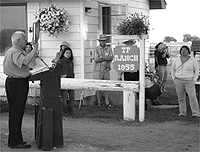During wars, the Constitution breaks down, said a former Minidoka Relocation Center detainee Saturday, after making his first pilgrimage in over 60 years to the camp near Twin Falls. Therefore, particularly during times of war, it is even more important to protect civil rights, he said remembering the words of a University of Michigan professor after his release as a young man.
One way to do that is to share stories about life in the camps where some 13,000 Japanese American citizens and legal resident aliens of Japanese ancestry from Washington, Oregon and Alaska were held, said Mako Nakagawa. Nakagawa, who is a writer, emceed a story-telling session during the annual Minidoka retreat last weekend. The event included two busloads of former internees, their friends, families and supporters.
"We're not getting any younger folks. Stories are really, really powerful."
In addition to recognizing those who were interned, the story of Japanese internment—as it becomes more widely heard—is beginning to include the families who were on the outside of the fence. This year, for the first time, pilgrims to Minidoka took a visit outside the 33,000-acre historic camp and convention center in Twin Falls to a neighboring ranch for a barbecue that included sushi and beef.
"How important for you to tell your story. If not now, lessons will be lost ... we, the rest of the world need to know," said Minidoka neighbor, ranch owner and former Jerome County Commissioner Roy Prescott, who hosted the barbecue at his family ranch.
Prescott shared his own story about how as a boy he stumbled onto the graveyard for deceased internees at the camp. "I felt like I had desecrated a sacred place for a People. It had a real sobering effect on me."
A number of community-minded and politically active Idahoans and Minidoka camp neighbors joined the pilgrimage meetings, including Mats Koto, 80, of Twin Falls, who as a 17-year-old spent 18 months at Minidoka and married a local in 1946. State Rep. Maxine Bell, chairwoman of the House Appropriations Committee, and Rick Phillips, a spokesman for the JR Simplot Co. Phillips emceed the event.
"For an Idaho farm boy, seeing somebody eat a potato with chopsticks just warms my heart," Phillips said, speaking about the importance of reconciliation and his hope that creating a new monument will help to usher in a new era of understanding about World War II history.
Getting to the roots of Minidoka history from both sides of the fence is part of the current effort to construct a Minidoka Internment National Monument on a portion of the original internment camp. The National Park Service this month released its draft of a general management plan this month, which describes the preferred alternative for the project to include on-site education and interpretation and cultural resource protection through reconstruction of a complete residential block at its original location. Public comment on the draft plan and the associated environmental impact statement will be accepted until Sept. 17.
One of the components of the monument that was discussed over the weekend was a memorial to the Issei, Japanese immigrants who came to the United States before the 30-year period of the Asian Exclusionary Act of 1924.
Many of those who joined the trip, including Emily Hanako Momohara, a graduate student from Lawrence, Kan., and chairwoman of the Friends of Minidoka, spoke about how the Issei were the adults in the camps. She said they are a humble generation and there are not many remaining. The goal is to get their first-hand accounts of the difficult period of U.S. history into the permanent record, because if they are not recorded the stories will soon simply become interpretations that are told by the Nisei (first generation citizens), most of whom were children or teenagers in the camp.
"The Issei story is in its twilight years," said Yosh Nakagawa, an inspirational speaker on the legacy of the Minidoka experience for Japanese Americans. "The National Park Service is wonderful to help us."
Nakagawa said it is now time for the Nisei generation to take the project, not just a Japanese-American story but an American story, to the finish line.
"What the American government did to American people should never be repeated," Nakagawa said. "It is a story that must take the myth out of the injustice."
The monument would become a permanent unit in the National Park system.
In addition to functioning as a testament to the relocation of Japanese-Americans during the war, it is also a memorial for patriots who fought for their country.
Momohara's grand-uncle, Arthur Doi, fought with the famed 442nd Battalion composed of Japanese-Americans. "He still goes to France and meets with the rebels (he helped to liberate from Nazi Germany)."


 Speaking at a barbecue hosted by rancher and former Jerome County Commissioner Roy Prescott, farmer Bill Vaughn shares his experiences as a young man when his father hired Minidoka internees, including renowned furniture maker George Nakashima, to help raise carrots, a critical crop for U.S. fighter pilots. Vaughn said he put the pieces together after seeing Nakashima's book, "The Soul of a Tree," in a museum book store. Looking in his father's ledgers at the farm, Vaughn confirmed the connection, but Nakashima died shortly before the men were scheduled to meet for a reunion. Express photos by Matt Furber
Speaking at a barbecue hosted by rancher and former Jerome County Commissioner Roy Prescott, farmer Bill Vaughn shares his experiences as a young man when his father hired Minidoka internees, including renowned furniture maker George Nakashima, to help raise carrots, a critical crop for U.S. fighter pilots. Vaughn said he put the pieces together after seeing Nakashima's book, "The Soul of a Tree," in a museum book store. Looking in his father's ledgers at the farm, Vaughn confirmed the connection, but Nakashima died shortly before the men were scheduled to meet for a reunion. Express photos by Matt Furber



































